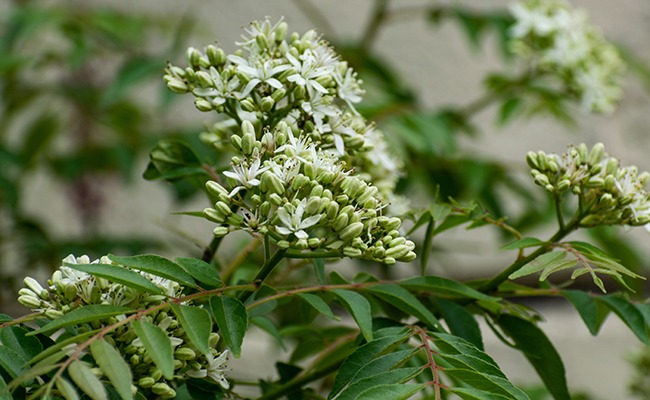The kaloupile (Murraya koenigii) or caloupilé, also called curry leaf, curry tree, cary or Kadi Patta, is a tree native to tropical Asia, particularly India and Thailand, which can hardly stand the cold: it suffers below 12°C and dies at 0°C. However, it can be grown in a pot in our latitudes.
The kaloupilé whose growth is slow, forms a shrub with a trunk and slender branches giving it a delicate silhouette, an impression reinforced by its type of foliage.
Its evergreen, pinnate leaves, composed of 11 to 21 oval, thin, opposite leaflets, each measuring up to 4cm long and 1 to 2cm wide, shiny dark green, reach about thirty centimeters. They are very aromatic giving off a smell of curry when crumpled and their taste is close to that of spice, which makes them attractive for use in cuisine, particularly Indian. Be careful, the curry leaf is different from what is called curry, this mixture of orange-yellow spices that flavors and colors dishes.
Small fragrant white flowers reminiscent of the cymes ofwild garlic (Allium ursinum) appear a little throughout the year, followed by a fruiting of shiny black berries which are edible after removing the seed which is poisonous.
The kaloupilé tends to sprout, which will not affect a pot culture, but in its natural environment, it manages to spread quite quickly this way.
- Family: Rutaceae
- Type: evergreen shrub
- Origin: India, Thailand
- Color: white flowers
- Sowing: yes
- Cutting: no
- Planting: spring
- Flowering: indeterminate
- Height: 1 to 1.50 m (5 to 8 m in its original environment)
Ideal soil and exposure for kaloupilé
Kaloupilé is grown in a sunny or semi-shaded, warm position (18-20°C), in light, humus-rich and well-drained soil, i.e. a good compost-rich soil to which you will add sand. Better to keep it away from drafts and radiators.

Date of sowing, cutting and planting of kaloupilé
Fresh seeds are sown as soon as they are harvested, generally in autumn, in a light, sandy mixture, warm at 25°C. Germination can be long (3 months).
Planting will be done when the young plants have reached 15-20cm, in a larger pot.
Semi-ripened cuttings are taken at the beginning of summer.
If suckers appear, they can be detached to be replanted.
The necessary repotting as it develops is planned during the growth period, in spring or summer.
Council of maintenance and culture of the curry tree
In summer, the kaloupilé can be taken out on the terrace, but you must not forget to bring it inside before winter when it must be in a room with a temperature exceeding 15°C.
As an indoor plant, it must be watered regularly in summer, including the leaves, but in winter the waterings must be much more spaced out.
Harvesting, storing and using curry leaves
The leaves of the curry tree are harvested as needed but do not keep for more than 24 hours or so, they will have to be dried for later use. Fresh leaves can also be frozen.

Curry leaves are added to many cooked dishes (soups, curries) to enhance the taste: they are used whole, in the sauce or fried in oil at the start of cooking with the onions to give all their taste, such as advises Stéphanie Mahon in her book Aromatic plants* particularly exhaustive on all the fragrant herbs to have in the garden or on a balcony.
An oil is extracted from the leaves of kaloupilé whose use is intended for cosmetics.
In traditional Ayurvedic medicine, its roots, bark and leaves are prized for their healing, analgesic, anti-inflammatory properties…
Diseases, pests and parasites of kaloupilé
The kaloupile is sensitive to aphids and other insects common to indoor plants.
Location and favorable association of the caloupilé
It is a plant that is grown, in our latitudes, mainly as a houseplant.
Recommended species and varieties of Murraya for planting in the garden
Genre Murraya has 5 species including the kaloupile (Murraya koenigii) has a prominent place. There is also Chinese boxwood (Murraya paniculata) or jasmine wood whose white flowers smell of jasmine, but which will also be grown indoors…
* Editions Eyrolles – 144 pages – September 8, 2022 – €15.90
We wish to thank the author of this write-up for this remarkable material
Kaloupilé (Murraya koenigii), the curry leaf: planting, caring
Discover our social media profiles and other pages that are related to them.https://nimblespirit.com/related-pages/

